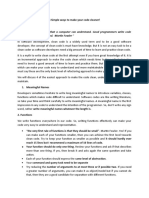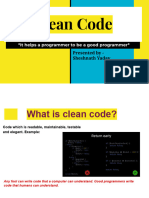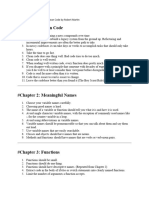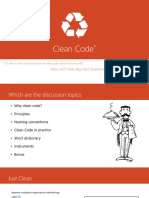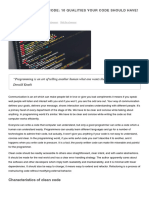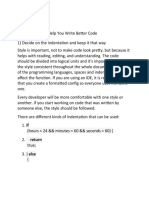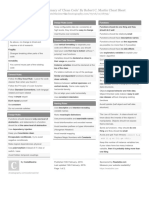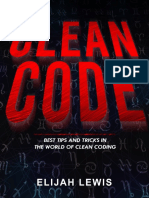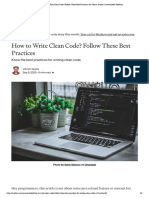Clean Code - Building Bug-Free and
Maintainable Software
Smitha Mave
“The ratio of time spent reading (code) versus writing is well over 10 to 1 ... (therefore) making it
easy to read makes it easier to write.” ― Robert C. Martin
Writing clean code not only showcases a developer's understanding of programming principles and
commitment to quality, enhancing their professional reputation and potential, but also contributes to
a better overall experience for both developers and users, leading to more efficient development,
more reliable software, and a smoother user experience.
What is Clean Code?
“You know it’s clean code when the routine you read turns out to do pretty much what you expected”
● Code that is easy to read, understand, and modify.
● Prioritizes clarity, simplicity, and maintainability.
● Adheres to conventions and best practices for consistency.
● Free of unnecessary complexity, redundancy, and confusion.
Benefits of Clean Code:
● Increased developer productivity: Easier to understand and work with.
● Reduced errors: Clarity aids in debugging and prevents mistakes.
● Improved maintainability: Easier to update and adapt to changes.
● Enhanced collaboration: Clearer for multiple developers to work on.
● Better code quality: Adheres to standards and best practices.
Best Practices for Writing Clean Code:
1. Meaningful Names:
● Use descriptive names for variables, functions, classes, and other elements.
● Avoid abbreviations and single-letter names.
● Choose names that clearly convey the purpose and intent of the code.
2. Single Responsibility Principle (SRP):
● Each function or module should have only one responsibility.
● This keeps code focused and easier to understand.
● Avoid functions that do multiple unrelated tasks.
3. Keep It Short and Simple (KISS):
● Write concise and to-the-point code.
● Break down complex logic into smaller, more manageable functions.
● Use clear and logical control structures.
4. Code Comments:
● Add comments to explain complex code sections or non-obvious logic.
● Use comments to clarify intent, not repeat code.
● Keep comments concise and up-to-date.
5. Indentation and Formatting:
● Use consistent indentation and formatting to improve readability.
● Follow language-specific conventions and style guides.
● Use whitespace effectively to create visual clarity.
6. Refactor Regularly:
● Review and improve code continuously.
● Refactor to remove duplication, simplify logic, and improve structure.
● Don't be afraid to change code to make it cleaner, even if it's already working.
7. Test Driven Development (TDD):
● Write tests before writing code to ensure it meets requirements.
● Tests help catch errors early and ensure code quality.
● Use a testing framework appropriate for your language.
Additional Tips:
● Follow coding conventions and style guides: Ensure consistency and readability.
● Use meaningful error messages: Help with debugging and understanding issues.
● Handle edge cases and exceptions: Prevent unexpected errors and crashes.
● Write code for people, not machines: Prioritize human readability.
● Collaborate with other developers: Get feedback and share best practices.
● Read and learn from clean code examples: Model your coding style after well-written code.
Reference: Clean Code: A Handbook of Agile Software Craftsmanship





